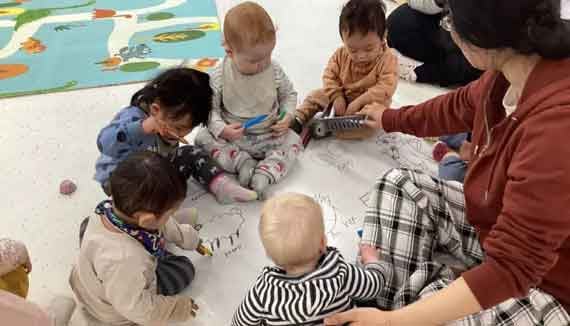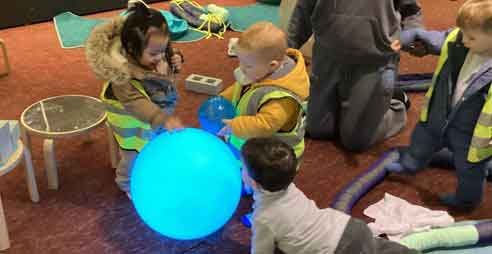Baby Programme
Our baby programme focuses on developing 3 foundations: Communication & Language, Physical Development and Personal Social & Emotional Development. Think of them as the foundation stones - they are the pillars that provide your child with the ability to confidently express themselves; navigate their physical and emotional spaces; and understand their sense of self in the context of a social group.
1. Communication & Language
Communication and Language are the underpinnings of the child’s entire educational experience with us. It allows children to comprehend, be communicative and confidently engage in new aspects of learning. Despite the fact that babies are preverbal, it is widely known to be the most important age for us to establish communicative abilities through regular interactions, songs, rhymes, stories and engagement.
Talk and Sing
Our staff focus on a simple pedagogical principle in this age group: “Talk and Sing” using our own bilingual songbook and bilingual story compendium to further regular music, rhyme and narrative in the lives of our children.
Makaton
Makaton is a system of using signs and symbols to support communication, which is a helpful tool in encouraging communication for babies in our bilingual nursery setting. We start with basic signs - simple and relevant to the baby's daily routine. These "scaffolding" signifiers are useful benchmarking tools to help us ground the consistency in communication with babies before expanding our vocabulary sets.
Milestones & Markers
We focus on the McArthur Bates Communicative Developmental Inventories (CDIS) for Words & Gestures, at this age (8-18 months), moving into “Words & Sentences” towards the end of their time in the baby room. We aim to achieve acquisitive rates in line with monolingual children, as outlined to the right.
Your baby should be responding to familiar voices and the sound of their own name, and making regular babbling noises.
Your baby will start using single words, pointing at things and making gestures in a basic attempt at communicating.
Although not clear, your baby should be able to say 5-10 words, as a sign of language development.
Your toddler will listen and respond to simple instructions like "Please, put on your shoes” and will expand their vocabulary to 10-20 words.
Your child should master up to 25-50 words and start structuring simple sentences and should be able to understand up to 350.
2. Physical Development
Physical activity is vital in children’s all-round development, enabling them to pursue happy, healthy and active lives. Gross and fine motor experiences develop incrementally throughout early childhood, starting with sensory explorations and the development of a child’s strength, coordination and positional awareness through tummy time, crawling and play movement with both objects and adults.
Indoor Gymnastics
Ensuring that babies have sufficient physical equipment to help stimulate gross and fine motor controls is hugely important. With this we encourage them to develop their physical abilities - sitting, crawling, walking, holding, hopping and jumping. And they also learn to manipulate media, draw, write and build the capacity to be aware of their limits, and risks, to be able to navigate them confidently.


Heuristic Play
Heuristic play is a type of play that involves exploring and discovering objects and materials through touch, sight, and sound. We use enabling environments - physical play spaces that are replete with resources to nurture and encourage this natural curiosity across all forms of media, materials, musical instruments and natural resources to stimulate that sensorial development.
Milestones & Markers
At this age, we’re looking for babies to stand up and sit down, and pick up something with his/her fingers and thumb.
We’re looking for fully mobile toddlers who can run, kick a ball, jump with both feet, start climbing and possibly pedalling small trikes.
3. Personal Social & Emotional Development
Helping children develop their self-confidence and social awareness in the context of their relationships with other adults and children is a fundamental part of what we do. Learning to make friends, establish boundaries and manage our own feelings and behaviour is a critical part of socialising the child and one of the primary advantages of a nursery school over, say a childminder or nanny.
Sensory Play
Sensory Play is a fun, playful and effective way of enhancing learning and promoting critical developmental skills for young children. Similar to Heuristic play, it stimulates all 5 senses by providing children with immersive experiences that maximise their sight, sound, smell, taste and touch. We do this by bringing the best early years educational equipment and natural resources in textures to ensure that children have a hugely rewarding explorative experience, learning to familiarise themselves with the wonderfully rich experiences we can provide them within our baby space.

Milestones & Markers
We’re looking for social awareness: baby is responding to his/her own name when called and is sensitive to the emotions communicated in speech.
This awareness extends to be cognisant of those familiar and those who are not. The attachment to key person and parent is manifest and the Strange Situation Experiment becomes apparent.
The toddler should be both mobile and curious about his/her environment, exploring the areas of the setting and the resources within it in full.
Children start seeing themselves as a separate person with their own desires and wishes that need to be fulfilled. You may start seeing tantrums appearing, which is children realising what they want and desire to enforce it.
The Baby Room Routine
Everyone thrives in a routine. Don't believe it when people say "I hate routine"...what they mean is that they hate monotony. For us all to become effective adults, we need to develop the sense of rhythm that a good routine can afford us - it provides regularity, consistency and, through that, a sense of control, which inspires confidence, security and so much more.
.webp?width=200&height=114&name=Hatching%20Dragons-Logo-v2-01-2-1%20(1).webp)


